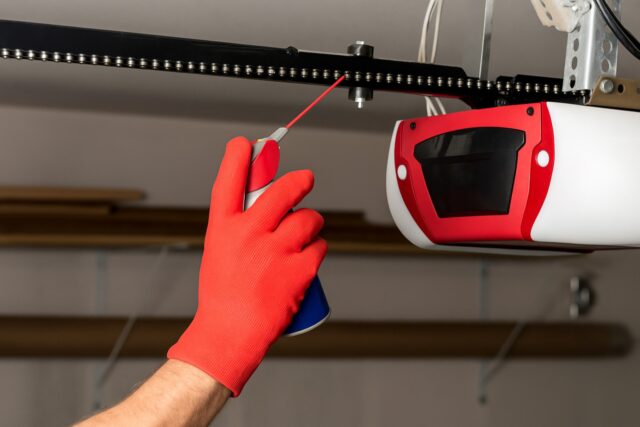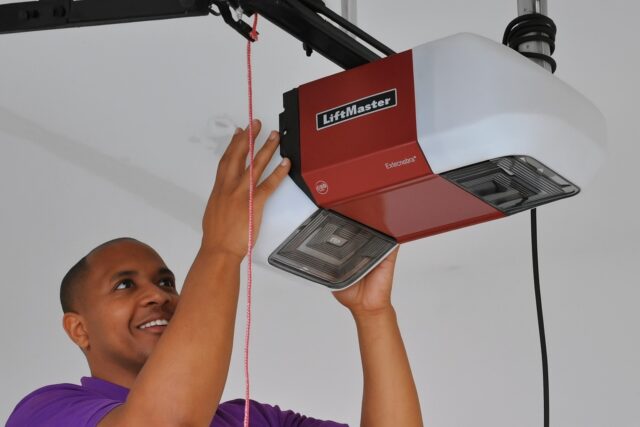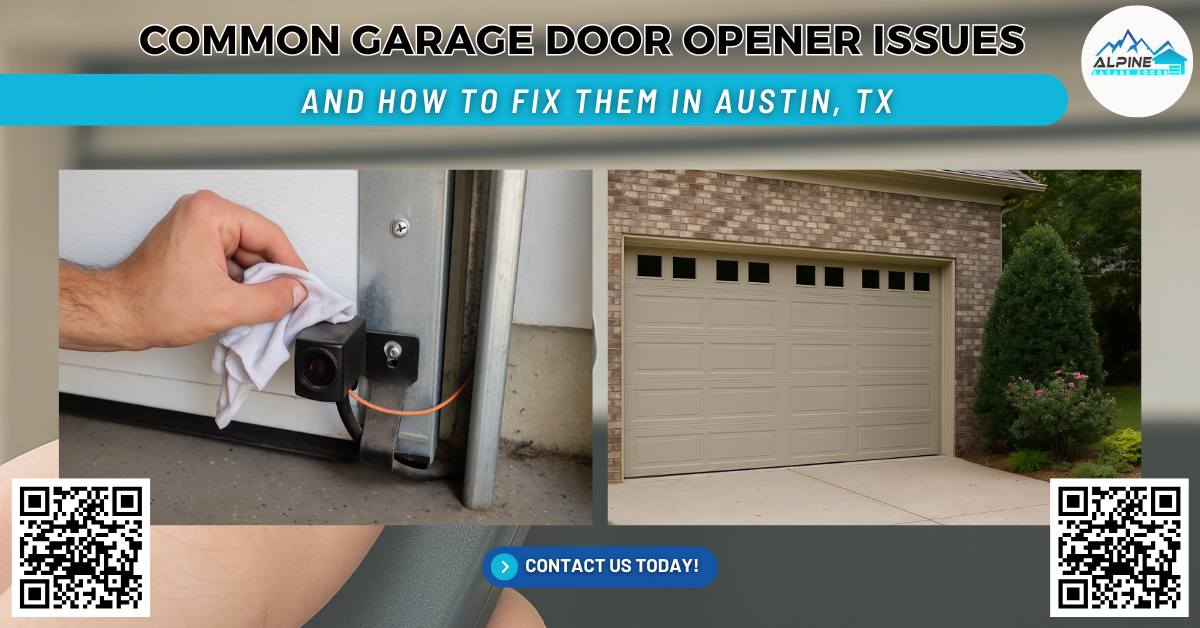Your garage door opener is the quiet hero of your home. When it works, you tap a button and glide into your garage without a second thought. When it does not, your day can come to a sudden stop. At Alpine Garage Doors Texas, we see how a fast and careful garage door opener repair restores convenience, protects your belongings, and keeps your family safe. This guide explains the most common opener problems, practical fixes you can try, and the best times to call our trained technicians for a professional solution.
Here is a real Austin story. An early morning call came from a parent whose garage door would not close before school drop-off. The door kept reversing with blinking lights. Our team arrived, cleared dust from the photo eyes, leveled the sensors with a small bubble level, and reset the travel limits. The repair took a single visit, and the system worked with smooth operation again. This is a common situation in our area where dust, wind, and minor bumps to the sensors create a problem that feels big yet has a straightforward fix.
Another common case involves older openers that struggle during a summer heat wave or after a storm. Power fluctuations can weaken logic boards and leave remotes unreliable. We often install surge protection, reprogram the rolling code, and check the battery backup to avoid future disruptions. Small steps like these prevent bigger repairs over time and give you confidence that your opener will work when you need it.
Understanding How Garage Door Openers Work
A garage door opener is a coordinated system of parts that includes a motor unit mounted to the ceiling, a rail and trolley that move the door, a drive system such as a chain, belt, screw, or direct drive, and control devices like remotes, keypads, and wall consoles. Safety sensors near the floor watch for people and objects. A logic board processes every command, manages safety features, and stores your access code and remote settings.
Modern garage door openers add useful features. Rolling code technology creates a new access code for every use, which improves security. Battery backup lets you open and close the door during an outage. Wi Fi connectivity allows smartphone control and alerts. Many models integrate with home security systems and smart home platforms, so you can check door status from anywhere.
Knowing your drive type helps with troubleshooting.
- Belt drive openers use a reinforced belt to move the trolley. They run quietly and are a good choice for homes with bedrooms above or next to the garage.
- Chain drive openers use a metal chain. They are strong and budget-friendly, though they can create more noise as parts age.
- Screw drive openers use a threaded steel rod. They have fewer moving parts and are reliable in clean environments.
- Direct drive openers move the motor along the rail. This design creates very low vibration and simple maintenance.

Quick Safety Checklist Before You Start
Working around a garage door involves heavy parts, spring tension, and moving machinery. Review this checklist before any do-it-yourself work.
- Disconnect power at the outlet if you are opening the motor housing.
- Do not loosen or adjust torsion springs or lift cables. These parts hold high tension and require trained technicians.
- Keep children and pets away from the work area.
- Use a sturdy ladder and keep your hands clear of the door path.
- If you smell burning, see smoke, or hear loud grinding from inside the opener, stop and call a professional immediately.
Common Garage Door Opener Issues With Practical Fixes
The door does not open or close
Likely causes include no power at the outlet, a tripped breaker, a loose plug, a locked wall control, a disengaged emergency release, or blocked safety sensors.
Try this
- Confirm the opener is plugged in and that the outlet has power.
- Check the breaker and reset if needed.
- Look at the wall console. If the lock light is on, unlock it to restore remote function.
- Make sure the red emergency release is re-engaged with the trolley. Pull the cord toward the opener to reconnect.
- Wipe the sensor lenses with a soft cloth and align both photo eyes until each LED shows a steady light.
If the motor hums but the door does not move, the main gear may be worn or the chain or belt may be off the sprocket. This needs a careful inspection, and it is a good time to call Alpine Garage Doors Texas.
The door reverses at the floor
This is usually a travel limit issue. The opener thinks the floor is an obstacle and reverses to protect the door.
Try this
Open the motor cover or find the small limit adjustment screws on the back. Turn the close limit a little in the direction that tells the door to travel farther. Test in small steps. If the door still reverses, check the bottom seal and tracks for debris. Clean the sensors again since a weak sensor beam can trigger a reverse.
The remote or keypad is unresponsive
Likely causes include weak batteries, a locked wall control, radio interference, or a lost code memory.
Try this
- Replace the remote battery and keypad battery.
- Extend the hanging antenna on the opener and clear dust and cobwebs.
- Press the learn button on the opener and reprogram the remote following your model instructions.
- Move or unplug nearby devices that can create interference, such as certain LED bulbs, baby monitors, or routers placed right above the opener.
If remotes only work within a few feet, the receiver on the logic board may be failing. We can test and replace the board to restore the normal range.
The opener makes a loud noise
Rattling and clanking usually point to loose hardware or a dry chain. Grinding from inside the housing can indicate a worn gear.
Try this
Tighten the opener mounting bolts, rail bolts, and the door hinge and roller bracket screws. Lubricate metal rollers, hinges, and the chain with a silicone-based garage door lubricant. Do not over-tighten the chain. It should sag slightly at the midpoint. If the noise continues and seems to come from inside the opener, schedule a diagnostic. Worn internal gears are replaceable, and a timely repair prevents more costly damage.
The door moves slowly or stops mid-travel
A heavy door creates strain on the motor. This often means spring tension is off or rollers are binding.
Try this
Close the door and pull the emergency release to place the door in manual mode. Lift the door by hand. A balanced residential garage door should lift with steady effort and stay about halfway open without rising or falling. If it drops or feels extremely heavy, do not keep lifting. This is a spring issue that needs professional adjustment. Lubricate rollers and hinges, then restore the trolley and test again.
The lights flash, and nothing happens
Most openers flash at the light bulb when the safety system detects a fault. The count of flashes helps identify the problem.
Try this
Clean and align the sensors again. Check the sensor wires for staples or damage along the wall. Make sure the door tracks are straight and that nothing rubs on the door. If your opener shows a specific error code on the console, note it and call our team for guidance.
The door opens by itself
This is a security and safety concern. Common causes include a stuck wall button, a neighbor’s remote using an older fixed code, or an electrical fault.
Try this
Disconnect the wall button and test with a remote. If the issue stops, replace the wall control. Clear the memory on the opener and reprogram your remotes to refresh the rolling code. If the problem continues, the logic board may be shorting. We will inspect and replace the board if needed.
The door will not open during a power outage
If your opener has a battery backup, the battery may be depleted.
Try this
Pull the red emergency release to open the door manually. If it feels too heavy, stop and call a professional. Replace the backup battery as recommended by your manufacturer. Consider upgrading to a LiftMaster model with battery support if your current opener does not have this feature. Summer storms and occasional grid events in Central Texas make battery backup a smart choice.
Troubleshooting By Opener Type
Chain drive openers
Look for dry chain links, loose chain tension, and worn sprockets. Lubricate the chain and adjust tension so there is a small sag. Chain drive ones are durable and respond well to regular maintenance.
Belt drive openers
Inspect the belt for cracks or frayed edges. If the belt slips, adjust the tension according to your model instructions. Belt drive openers excel at quiet operation in a residential garage with living space nearby.
Screw drive openers
Clean the threaded rod and apply the manufacturer-approved lubricant. Dirt buildup can cause hesitation or chatter. Screw drive systems perform best when kept clean.
Direct drive openers
These models are quiet and have simple mechanics. Listen for unusual motor sounds. If travel becomes inconsistent, check the rail alignment and trolley adjustment and then review the travel limits.
Seasonal Tips For Austin, TX
- Summer heat can thin lubricants and stress plastic parts. Refresh lubrication with a high-quality garage door product, never with heavy grease.
- Spring storms can cause power surges. Use a surge protector on the opener outlet to protect the logic board.
- Dust and pollen collect on safety sensors. Wipe lenses monthly during peak seasons.
- Garage insulation and weather stripping help with energy savings and comfort. An insulated door with a solid R value reduces heat transfer and helps the opener lift a lighter effective load over time since temperature control reduces swelling and drag.
Programming Remotes and Keypads
- Locate the learn button on the opener housing.
- Press and release the learn button. A light will turn on.
- Within thirty seconds, press the remote button you want to program. The opener light will blink.
- For a keypad, press learn, enter your chosen access code on the keypad, then press enter.
- Test the remote and keypad from the driveway. If the range is poor, check the antenna and remove interfering bulbs.
Rolling code technology refreshes the access code each time. This prevents replay attacks and adds extra security for your home.
Smart Features, Security, and Battery Backup
Many Austin homeowners like app control for alerts and remote access. Smart features allow you to check if the garage door is closed, schedule auto-close at night, and receive notifications during school drop-off times or deliveries. Battery backup keeps these features working during an outage. Smart locks and camera integrations create a complete security system where your garage door becomes part of a safe daily routine.
DIY Versus Professional Repair
Good DIY tasks
- Replacing remote and keypad batteries
- Cleaning and aligning sensors
- Lubricating rollers, hinges, and the drive chain
- Adjusting small travel limit settings
- Replacing light bulbs with safer bulbs
Professional only tasks
- Torsion spring and extension spring work
- Cable replacement and bottom bracket service
- Motor, gear, sprocket, and logic board replacement
- Track alignment that requires door unloading
- Full opener installation and wiring
Choosing the right help saves time and improves safety. Our technicians arrive with the correct parts, precision tools, and the experience to finish the job in a single visit whenever possible.
Cost Factors and When Replacement Makes Sense
Repair costs depend on the part, the age of the opener, and the condition of the garage door itself. A balanced, well-maintained door reduces strain on any opener. If your opener is near the end of its expected years of service and needs a motor and logic board, a replacement may offer better value.
Consider a replacement if you want quieter operation, stronger lifting power for a heavy insulated door, better safety features, battery backup, or smart control. Many families in the Austin area choose a belt drive LiftMaster with battery support for a quiet bedroom experience and reliable performance during storms. We provide clear options and free estimates so you can decide with confidence.

Routine Maintenance Plan For Long-Term Reliability
Create a simple plan that fits real family life.
Monthly
- Test safety reverse by placing a two-by-four flat on the floor under the door. The door should reverse when it touches the board.
- Check the photo eyes for steady lights and clean the lenses.
- Listen for new noises during operation.
Every six months
- Lubricate rollers, hinges, and the chain or threaded rod.
- Tighten all visible bolts on the opener and the door hardware.
- Replace remote and keypad batteries if needed.
Annually
- Schedule a professional tune-up. We will check the spring balance, cable condition, travel limits, safety sensors, and opener electronics.
Small maintenance steps prevent costly repairs and protect the door, opener, and your home.
Common Mistakes To Avoid
- Using heavy grease on tracks and rollers. Grease collects dirt and creates drag. Use a silicone-based garage door lubricant.
- Ignoring slow operation and loud noise. These are early signs that save money when addressed promptly.
- Bypassing safety sensors. Never tape sensors up high or aim them away. They protect people, pets, and vehicles.
- Pulling the red release cord while the door is open without support. The door can fall quickly.
- Installing a very strong opener to lift a door with unbalanced springs. Fix the door first so the opener works within design limits.
Extra Notes On Brands, Models, and Online Terms You May See
Homeowners often research garage door openers online and run into many brand names, model families, and national franchise references. You may read about Precision Garage Door, Veteran Garage Door, Welborn Garage, and other companies that serve different locations such as Dallas, North Dallas, Fort Worth, Little Elm, or areas outside Texas, such as the Orlando Area, Central Florida, Greater Orlando Area, Baton Rouge, Cordova, or Shelby County. You may also see general terms like national franchise, online garage door, or showroom-style garage displays. These searches can help learn about different types of door openers, safety features, and technology. When you want local garage door support in the Austin area, Alpine Garage Doors Texas is your nearby partner for residential garage door opener repairs, new garage door opener installation, and careful maintenance.
We also service a wide range of models beyond LiftMaster, including many common garage door openers found in homes across Texas. Whether you own chain drive openers, belt drive openers, screw drive openers, or direct drive openers, our technicians bring the right parts and knowledge to your location for a smooth and simple repair experience.
Frequently Asked Questions (FAQs)
- How do I know if my garage door opener needs a complete replacement instead of a repair?
If your opener is over 10–15 years old, makes loud grinding noises even after maintenance, or frequently stops mid-operation, it might be more cost-effective to replace it. Newer models offer advanced safety features, better energy efficiency, and smart technology for improved convenience.
- Can extreme Texas weather affect my garage door opener’s performance?
Yes, Austin’s hot summers and sudden storms can impact your opener. Heat can dry out lubricants and weaken plastic parts, while lightning or power surges can damage the motor or circuit board. Regular tune-ups and surge protection can prevent these issues.
- Why does my garage door opener light bulb burn out frequently?
Frequent bulb burnout is often caused by vibration from the opener motor or the use of standard bulbs not designed for openers. Using heavy-duty, vibration-resistant LED bulbs rated for garage door openers can solve this problem.
- Are smart garage door openers worth upgrading to?
Absolutely. Smart openers allow you to monitor and control your garage door from your smartphone, receive real-time alerts, and integrate with home security systems. They add convenience, safety, and peace of mind for busy homeowners in Austin.
How Can Alpine Garage Doors Texas Help You
When your garage door opener needs attention, call today and talk to a friendly member of our team. We offer careful diagnostics, same-day solutions when available, free estimates, and precise workmanship that respects your time and your home. Our goal is a smooth operation opener, a safe and balanced door, and a great experience from the first call to the final test.
We handle residential and commercial projects, replacement and installation, and ongoing maintenance. Our trained technicians service a wide range of models and parts. We focus on safety, security, and reliable access for your daily routine. We bring the right tools, arrive prepared, and aim for a single-visit repair whenever possible.
Address 638 Saddle Rock Dr, Houston, TX 77037
Phone 346 438 1138
Call now for professional garage door opener repair in Austin, TX. We are ready to help today with a courteous garage door service that keeps your system running with precision and care.
Final Thoughts
A dependable garage door opener supports your daily life. Clear sensors, smooth tracks, balanced springs, and a healthy motor work together to move a heavy door with quiet confidence. Small habits like monthly safety tests, periodic lubrication, and quick attention to new noises make a real difference. When a problem appears, use the practical steps in this guide to solve simple issues, and reach out to Alpine Garage Doors Texas for anything that needs expert tools and training.
From fast fixes to smart upgrades, our team stands behind every service with honest guidance and careful workmanship. Keep this guide handy, schedule regular maintenance, and enjoy the comfort, safety, and security that a well-cared-for garage door opener brings to your home for many years.

